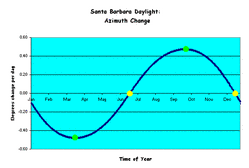Mr. Growitall- I could see how you could see earlier blooming with clones planting after the solstice, but with seed grown plants it is a different matter.
Seeds started later than mid June often lag behind their earlier sisters, I once tried starting plants in early July and ended up harvesting 3 weeks later than their April started sisters.
Generally, the basic rule is that most photo sensitive strains(that being any strain that uses light cycles to trigger bloom) of Cannabis gain the ability to bloom(mature) at about 7-9 weeks of age.
Now take a strain that is triggered to bloom @ July 25th, if you started the seeds around June 25th(the solstice is June 21st) that would give the plants 4 weeks to start blooming. Chances are the plants wouldn't be triggered for at least 3 weeks more, when they are more mature, even if they did bloom on time they would be tiny!
But like I said, I can see how this might work with clones Vs. seed grown plants, considering that they are mature already at planting, just waiting to bloom!
I disagree with the idea that the moon has anything to do with starting bloom, photosenstive plants(not just Cannabis) can not register moonlight because it is too weak to trigger their photchromatic cells. It does not seem to play any role what so ever.
Seeds started later than mid June often lag behind their earlier sisters, I once tried starting plants in early July and ended up harvesting 3 weeks later than their April started sisters.
Generally, the basic rule is that most photo sensitive strains(that being any strain that uses light cycles to trigger bloom) of Cannabis gain the ability to bloom(mature) at about 7-9 weeks of age.
Now take a strain that is triggered to bloom @ July 25th, if you started the seeds around June 25th(the solstice is June 21st) that would give the plants 4 weeks to start blooming. Chances are the plants wouldn't be triggered for at least 3 weeks more, when they are more mature, even if they did bloom on time they would be tiny!
But like I said, I can see how this might work with clones Vs. seed grown plants, considering that they are mature already at planting, just waiting to bloom!
I disagree with the idea that the moon has anything to do with starting bloom, photosenstive plants(not just Cannabis) can not register moonlight because it is too weak to trigger their photchromatic cells. It does not seem to play any role what so ever.
Last edited:




 Agreed on all points
Agreed on all points 
